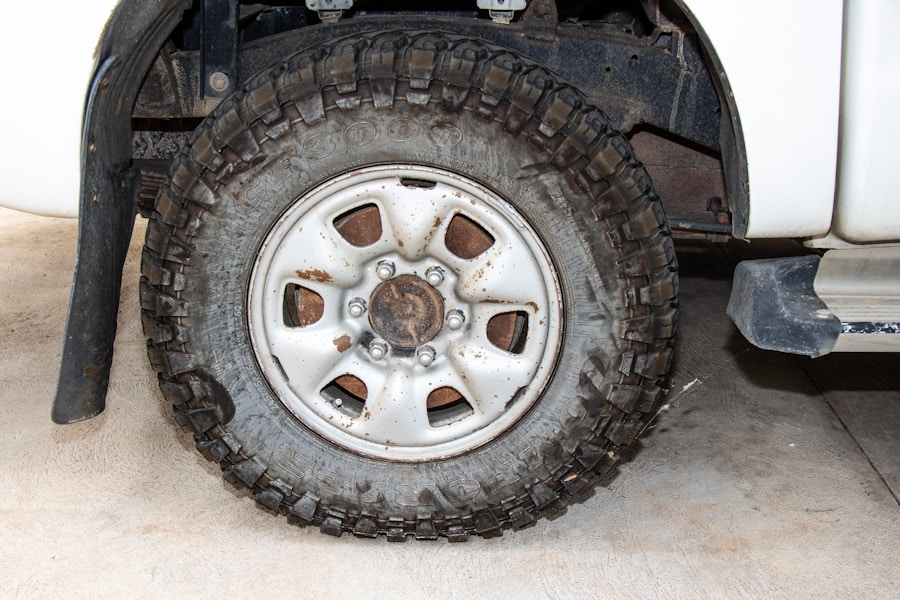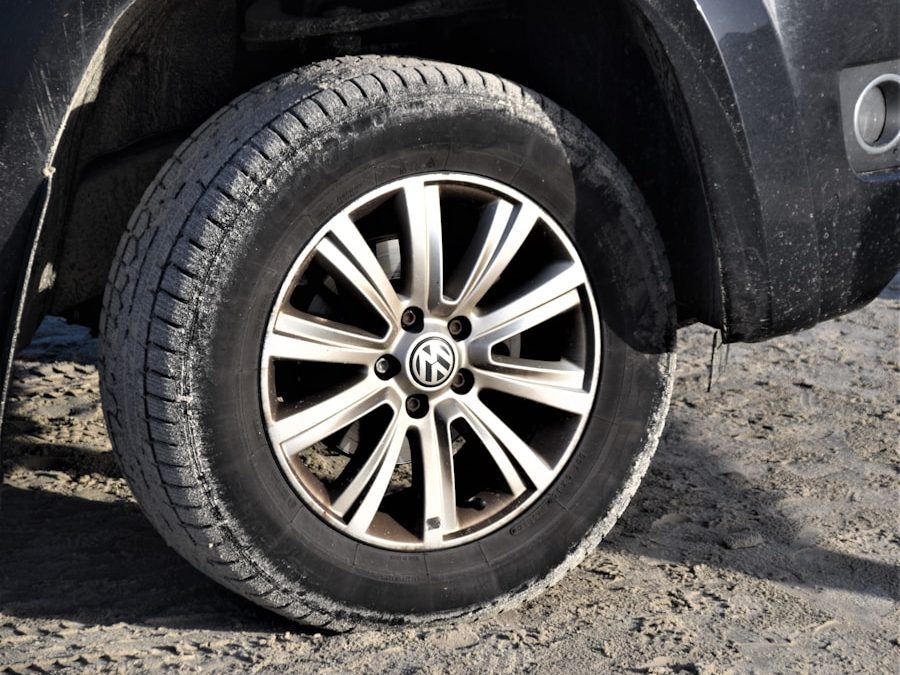A temporary spare tire, often referred to as a “donut” tire, is a compact, lightweight tire designed to be used as a short-term solution in the event of a flat tire. Unlike full-sized spare tires, which are typically the same size and type as the tires on the vehicle, temporary spares are smaller in diameter and width. This design allows for easier storage in the trunk or under the vehicle, making them a practical choice for many drivers.
The tread pattern on a temporary spare is also different, often featuring a more shallow tread depth that is optimized for limited use. The primary purpose of a temporary spare tire is to enable drivers to safely reach a repair shop or tire service center after experiencing a flat. These tires are not intended for long-term use or high-speed driving.
Manufacturers usually recommend that temporary spares be used only until the original tire can be repaired or replaced.
Key Takeaways
- A temporary spare tire is a smaller, lighter tire designed for short-term use in case of a flat tire.
- You can drive on a temporary spare tire, but it is only meant for short distances and at lower speeds.
- Risks of driving with a temporary spare tire include reduced handling, stability, and braking capabilities.
- You should only drive on a temporary spare tire for about 50 miles and at speeds no higher than 50 mph.
- Most insurance policies cover driving on a temporary spare tire, but it’s important to check your specific policy for details.
Can You Drive on a Temporary Spare Tire?
Yes, you can drive on a temporary spare tire, but it is essential to adhere to specific guidelines to ensure safety. Temporary spares are engineered to support the weight of the vehicle and provide adequate traction for short distances. However, they are not designed for prolonged use or high-speed travel.
Most manufacturers recommend that drivers limit their speed to 50 miles per hour when using a temporary spare. This speed restriction is crucial because the construction of these tires does not support the same performance characteristics as regular tires. Driving on a temporary spare tire can be a practical solution in emergencies, but it is important to remember that it is not a permanent fix.
The handling characteristics of the vehicle may change when using a donut tire, which can affect braking and cornering. Therefore, while it is permissible to drive on a temporary spare, it should be done with caution and an awareness of the limitations imposed by the tire’s design.
What are the Risks of Driving with a Temporary Spare Tire?

Driving with a temporary spare tire comes with several risks that drivers should be aware of. One of the most significant concerns is the reduced traction and stability that these tires provide compared to full-sized tires. The smaller size and different tread pattern can lead to compromised handling, especially in adverse weather conditions such as rain or snow.
This can increase the likelihood of losing control of the vehicle, particularly during sharp turns or sudden stops. Another risk associated with temporary spare tires is their limited durability. These tires are not built to withstand the same wear and tear as regular tires, which means they can wear out more quickly if driven over long distances or at high speeds.
Additionally, because they are often inflated to higher pressures than standard tires, there is an increased risk of blowouts if they are not monitored closely. Drivers should be vigilant about checking the air pressure and overall condition of the temporary spare before hitting the road.
How Long Can You Drive on a Temporary Spare Tire?
| Tire Type | Maximum Distance |
|---|---|
| Temporary Spare Tire | Around 50 miles |
The duration for which you can drive on a temporary spare tire varies based on several factors, including the manufacturer’s recommendations and driving conditions. Generally, most manufacturers suggest that temporary spares should only be used for a maximum distance of 50 to 70 miles. This limitation is primarily due to the tire’s construction, which is not designed for extended use.
The specific distance may vary depending on the make and model of the vehicle, so it is always advisable to consult the owner’s manual for precise guidelines. In addition to distance limitations, driving conditions can also impact how long you can safely use a temporary spare tire. For instance, driving on smooth highways may allow for longer use compared to navigating rough terrain or city streets filled with potholes.
The wear and tear on the tire will be greater in challenging conditions, potentially necessitating an earlier replacement with a full-sized tire. Therefore, while it may be tempting to extend the use of a temporary spare beyond its recommended limits, doing so can compromise safety and lead to further complications.
Are You Insured While Driving on a Temporary Spare Tire?
Insurance coverage while driving on a temporary spare tire generally falls under standard auto insurance policies; however, there are nuances worth considering. Most comprehensive and collision insurance policies will cover damages incurred while driving on any type of tire, including temporary spares. However, if an accident occurs due to negligence related to the use of a temporary spare—such as exceeding speed limits or ignoring handling issues—insurance companies may scrutinize claims more closely.
If your policy includes such stipulations, it may be wise to review them before relying on a temporary spare tire for an extended period. In any case, maintaining open communication with your insurance provider can help clarify coverage details and ensure you are adequately protected while driving under less-than-ideal circumstances.
What to Do if You Have to Drive on a Temporary Spare Tire?

Assessing Your Situation
If you find yourself in a situation where you must drive on a temporary spare tire, the first step is to assess your immediate surroundings and determine whether it is safe to drive at all. If you are in an area where you can safely pull over and wait for assistance or change your tire, that may be the best course of action.
Understanding Temporary Spare Tire Limitations
If driving is necessary, make sure to familiarize yourself with the limitations of your temporary spare tire. Check the air pressure before setting off; most temporary spares require higher inflation than standard tires—typically around 60 psi. Ensure that your vehicle’s handling feels stable and that you remain aware of any changes in performance as you drive.
Planning Your Route and Prioritizing Repair
Plan your route carefully, opting for roads that allow for lower speeds and minimal traffic whenever possible. Finally, prioritize getting your original tire repaired or replaced as soon as possible to avoid extended reliance on the temporary spare.
Tips for Driving Safely with a Temporary Spare Tire
Driving safely with a temporary spare tire requires vigilance and adherence to best practices. One of the most critical tips is to maintain a lower speed—ideally no more than 50 miles per hour—to reduce the risk of blowouts or loss of control. Additionally, avoid sudden maneuvers such as sharp turns or hard braking, as these actions can exacerbate handling issues associated with using a donut tire.
Regularly check your temporary spare’s air pressure during your journey; fluctuations in temperature can affect tire pressure significantly. If you notice any signs of wear or damage while driving—such as vibrations or unusual noises—pull over immediately and assess the situation. It’s also wise to keep an emergency kit in your vehicle that includes basic tools and supplies for changing tires, as well as reflective triangles or flares for visibility if you need to stop on the roadside.
How to Replace a Temporary Spare Tire
Replacing a temporary spare tire with a full-sized tire involves several straightforward steps that any driver can follow with basic tools and knowledge. First, ensure that your vehicle is parked on a flat surface and engage the parking brake for safety. Gather necessary tools such as a jack, lug wrench, and possibly wheel chocks if you have them available.
Begin by loosening the lug nuts on the wheel where the temporary spare is mounted; do this while the wheel is still on the ground to prevent it from spinning. Once loosened, use the jack to lift the vehicle off the ground until the wheel is clear. Remove the lug nuts completely and take off the temporary spare tire.
Place your full-sized tire onto the wheel hub, aligning it with the bolt holes. Once positioned correctly, hand-tighten the lug nuts onto the bolts before lowering the vehicle back down to ground level. After lowering, use the lug wrench to tighten each lug nut in a crisscross pattern to ensure even pressure across the wheel.
Finally, store your temporary spare properly in your vehicle and check that all tools are returned to their designated places before resuming your journey.
If you are wondering about the financial implications of driving with a temporary spare tire, you may want to check out this article on auto insurance coverage. Understanding your insurance policy and how it applies to different scenarios, such as driving with a temporary spare tire, can help you make informed decisions and avoid any potential financial risks. It’s always important to be prepared and informed when it comes to your auto insurance coverage.
FAQs
What is a temporary spare tire?
A temporary spare tire, also known as a “donut” or “space-saver” tire, is a smaller, lighter tire designed to be used as a short-term replacement for a flat tire. It is not intended for long-term use and has limitations on speed and distance.
Is it safe to drive with a temporary spare tire?
It is generally safe to drive with a temporary spare tire for short distances at low speeds. However, it is important to replace the temporary spare with a full-size tire as soon as possible, as it is not designed for extended use and may affect the handling and braking of the vehicle.
What are the limitations of a temporary spare tire?
Temporary spare tires are typically limited to a maximum speed of 50 mph and a maximum distance of 50 miles. They also have a smaller tread and may not provide the same level of traction as a full-size tire, especially in adverse weather conditions.
Are you insured when driving with a temporary spare tire?
Most auto insurance policies provide coverage for vehicles equipped with a temporary spare tire, as long as the tire is used in accordance with the manufacturer’s guidelines. However, it is important to check with your insurance provider to confirm coverage in case of any uncertainty.


